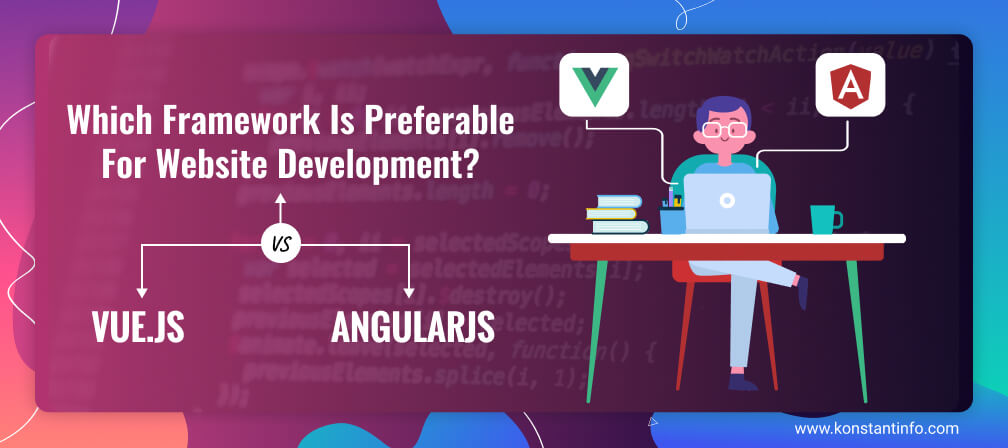
Table of Contents
For all the business owners who are looking for front-end development services – Vue.js and AngularJS pop-up as premier options for creating your web apps. Front-end development used to be based on JavaScript Frameworks earlier. Angular is basically used by larger enterprises owing to its predefined structure which ensures that every developer follows the same architecture. Vue allows developers to structure the project in the way they want, allowing the user to write their template in an HTML file or JavaScript file.
See also:
Size, Simplicity, Integration, Documentation and Flexibility are some of the adjectives that define Vue.js. Vue is a progressive framework for building web applications/websites. It is designed to be incrementally adoptable. Its core library is focussed on the view layer which makes it easy for the developers to pick and integrate with other libraries or existing projects. Vue.js can essentially power single-page applications when used in combination with modern tooling and supporting libraries. Declarative Rendering, Conditionals and Loops, Handling User Input and Composing with Components – are some of the adjectives that define Vue.js website development.
Clearly, as the core purpose of Vue.JS and AngularJS are similar few of the features of Vue.js remind the programmers of working with AngularJS like model binding, templating,event binding, loops, conditionals – work in a similar way for both frameworks. All these similarities can well be considered at the time of migrating Angular Applications to Vue.js as AngularJS developers > Vue.js developers (in numbers).
| Comparison | AngularJS | Vue.js |
|---|---|---|
| What it is? How it got started? | It was a project in Google, based on HTML and JavaScript to manipulate DOM objects by extending HTML and subsequent directives to create single-page applications (SPA’s) with the help of dependency injection and data binding. It converts HTML to dynamic HTML. It is a client-side JavaScript structural framework with MVC and MVVM for creating dynamic web applications. Angular is re-written and is an incompatible successor to AngularJS.
| This is a convenient, progressive front-end framework that came right after AngularJS as a lightweight option to create interactive and attractive single-page applications (web apps only) for enterprises. It can be easily picked up from existing projects and libraries.It is easy to understand, is easy to integrate and develop applications. |
| When it came up? | It was released in February 2012 (developed in 2008-2009 ) | It was released in February 2014 |
| Applicability | Used by Google, Forbes, Weather, Healthcare | Used by Alibaba, GitLab, etc. |
| Simpler Integration
| The overall deployment of AngularJS is quite complicated but making use of Angular CLI can help developers handle the project creation to code optimization with a single command. This way the app can be deployed to any static host in just one command. | Vue.js makes use of CLI that generates pre-configured robust set-up for hassle-free app development. Development in Vue.js is relatively easier than Angular as developers get optimized projects, running on a built-in command. It is easy to deploy Vue.js project on any static host and turn on the server-side rendering |
| Size and Load Time | 500+ KB; The huge size causes long loading and performance issues. Especially noticeable on mobile devices.Fast and average pace for front-end development. | 80KB; Everything is similar to Angular, just that this framework is extremely small in size, better than all major frameworks like React.js, Ember.js, AngularJS. Vue.js code works well even on the smallest smartphone.Lighter and faster than AngularJS. |
| Applicability | Few examples of the companies that have absorbed AngularJS into their applications:
| Few examples of the companies that have absorbed Vue.js into their applications:
|
| Is it complex? | There is a lot of associated information you should know to work: typescript, MVC and other. It has huge library. | It is simple in application programming interface and design and easy to learn. |
| How much is it flexible? | It has a standard structure, leaving not much space for creativity. | It has flexible modular solutions and easily adaptable for various projects. |
| How well does data-bind? | Two-way | One-way |
| Components and Directives | Directives are used for every task. Another type of directive is a component. | DOM manipulations are encapsulated through directives. Data logic and view of the components differs. |
| Time to develop? | It requires a complicated syntax for perform simple things. | Easy in setting up, does not require much time and changes in syntax. |
| Suits for? | Angular development suits for making large scale applications. | Suitable for making single-page applications, but can also be used to develop enterprise applications. |
| Is it backward compatible? | AngularJS development projects can’t be changed over to Angular 2 because of core contrasts. | It is backward compatible. |
| What Architecture does it follow? | It is based on MVC (Model View Controller). | It is based on the Virtual DOM (Document Object Model). |
| Can it inherit code? | It is not easy to merge angular code with others. | Vue code can be effectively merged with other code snippets |
| Experience | It is relatively established. | It’s relatively new but very popular |
The Angular Syntax is quite similar to Vue Syntax but it is mandatory to make use of TypeScript in Angular while Vue.js claims that making use of a type system may result in certain overheads which can affect program’s productivity/efficiency. Subsequently, Vue.js makes use of TypeScript’s Static Type Checking System (but its usage is not mandatory). Vue.js Developers can get going with a fully accomplished Vue.js website in just 24 hours time span with rapid application development (less opinionated than angular). Vue.js component holds more component logic than AngularJS. Contrastingly, Angular directives (components) are slightly more complex than Vue.js directives. Later clearly demarcates component from directives. Vue.js directives encapsulate DOM manipulations while Angular can address a wider range of use cases. Get dedicated Angular vs. Vue.js development from experienced and flexible teams from Konstant for enterprise application development.



Neeti Kotia is a technology journalist who seeks to analyze the advancements and developments in technology that affect our everyday lives. Her articles primarily focus upon the business, social, cultural, and entertainment side of the technology sector.
Or send us an email at: [email protected]